Modelling Prefabricated Construction Safety
Abstract
:1. Introduction
2. Research Method
- The selected business classifications for PC are mainly involved in house construction with prefabricated products. However, there is possibility of involvement in non-residential construction.
- The data demonstrate the reported accidents are within the jurisdiction of the selected PCC by business classifications; however, there are chances of non-reported accidents and incidents at offsite construction sites.
- Business activity is presumed to be reduced for a few months under a locked down period during March–April and August–October in 2020. However, Auckland was affected more than other cities.
- New claims are lodged to the ACC immediately after the injury occurred or at any later stage. Active claims were not considered for the data analysis, but only to determine the overall cost. The values that showed <4, as frequency, were considered equal to 3 to gain better descriptives.
2.1. Simplisitic Modelling of Prefabricated Construciton Safety
- (A)
- Accident index (AI): The accident index has been defined to determine the annual accident frequency retrieved from new claims only. This is a simplistic measure of accident frequency and is calculated using the following formula from 2017–2022. A number of workers is not required, as this information is not available nor helpful for comparing onsite and offsite accident frequency [36]. Normal working hours in the New Zealand construction industry are more than 50 h in NZ, including overtime [37].
- (B)
- Accident frequency rate (AFR): The accident frequency rate was calculated by using following formula [38]:
- Number of accidents for each specific year was sourced from ACC.
- 200,000 = 40 h × 50 weeks × 100 employee, as developed by the Occupational Safety and Health Administration (OSHA) [39].
- Total hours worked for onsite and offsite construction extracted from the Workforce Development Council (WDC) [40].
- (C)
- Elemental safety in PCS is modeled to understand the weightage of the sub-elements based on accident frequency of key aspects from the given period of 2017–2022. This provides the contribution of sub-elements in the overall element.
- W1 = Sum of sub-elements for all years/Sum of all sub-elements × 100
- S1 = Sub-element 1
2.2. Predictive Modelling of Prefabricated Construciton Safety
- y = regressions on itself lagged by the n-th period
- y′t = differenced series
- p = the number of autoregressions (AR)
- d = the number of seasonal differences
- q = the number of the moving average (MA)
- φi (i = 1,…, p) = Weights for AR
- θj (j = 1,…, q) = Weights for MA
- ε = Error term that reflects the previous state at present
- εt = residual term with mean zero
3. Results and Discussion
3.1. Accident index
3.2. Accident Frequency Rate
3.3. Accident Forecasting by Classification
3.4. Cost of Prefabricated Construction Safety
3.5. Vulnerable Occupations in Prefabricated Construction
3.6. Injuries in Prefabricated Construction Accidents
3.6.1. Type of Injuries
3.6.2. Causes of Injuries
3.6.3. Injury Prior Activity
3.6.4. Primary Injury Site
4. Conclusions
- The accident index has been relatively steady over the years for offsite in comparison to onsite. However, it was found that the workforce offsite has a 0.9 times chance while onsite has a 3.4 times chance to encounter accident situations at any hour of the day at workplaces.
- The accident frequency rate is almost twice as high as for offsite in comparison to onsite due to a smaller workforce.
- The ranking of the top business classifications by cost of safety, in ascending order, is Wood_S, Conc, Alum, and Metal_S. It was found the cost of safety for offsite is almost a third of the onsite cost.
- The most vulnerable occupations across all business classifications are ‘carpenters and joiners’, ‘labourers’, and ‘building and related workers’. However, the situation somehow varies for individual business classifications. Furthermore, the weightage of accidents for each occupation was determined under each classification. Interestingly, it was found that the occupations ‘carpenters and joiners’ and ‘labourers’ are safer offsite.
- The most common types of injuries offsite are ‘soft tissue’ and ‘laceration/puncture/sting’. However, multiple injury types are associated with business classifications. Furthermore, the weightage of injury types for each occupation was determined under each classification.
- The most common injury cause is ‘lifting/carrying/strain’, but less than half are associated with other causes. All injury causes offsite range from three to five times lower than that of onsite. Furthermore, the weightage of injury causes was determined under each classification.
- The most common prior activities to encountering injuries are ‘employment task’ and ‘lifting/lowering/loading/unloading’. Injury prior activities offsite range from three to six times lower that for onsite. Furthermore, the weightage of prior activity to injury for each occupation was determined under each classification.
- Primary injury sites on the human body are ‘lower back/spine’ and ‘finger/thumb’. However, the trend varies for other business classification types. Interestingly, primary injury sites offsite range from three to eighteen times lower than that for onsite for all types. Furthermore, the weightage of primary injury sites for each occupation was determined under each classification.
- Accidents are predicted to increase in companies for Alum, and Wood_P, but there will be a decline for Wood_S, Conc, and Metal_S. However, Metal_P will somehow remain steady. Overall, offsite will most likely see a gradual decrease, but onsite will have a fluctuating increase.
- The most vulnerable occupations have an increasing trend for ‘sheet metal workers’ under Metal_S and ‘carpenters and joiners’ under Wood_P. However, three of the occupations will likely decline, such as ‘carpenters and joiners’ under Wood_S, ‘operators’ under Conc, and ‘building and related workers’ under Alum. Interestingly, the ‘labourer’ under Metal_P will be steady.
- There is an increasing trend for injury types for ‘foreign body orifice or eye’ and ‘fracture or dislocation’. However, there will likely be a decline in ‘laceration/puncture/sting’ and ‘industrial deafness’, but ‘soft tissue’ will be steady.
- Injury causes most likely to increase are ‘lifting/carrying/strain’, ‘puncture’, and ‘work property/characteristics’, but there will be a decline for ‘object coming loose or shifting’.
- Prior activities to critical injuries likely to be more common are ‘employment task’ and ‘ascending or descending’. However, a steady trend has been observed for ‘lifting/lowering/loading/unloading’, and a decline in ‘using or operating’.
- The trending primary injury sites for the next five years are ‘shoulder’ and ‘eye’. However, there will likely be a decline for ‘finger/thumb’, ‘upper and lower arm’ and ‘knee’, but ‘lower back/spine’ and ‘hand/wrist’ are somehow steady.
Supplementary Materials
Funding
Institutional Review Board Statement
Data Availability Statement
Acknowledgments
Conflicts of Interest
Abbreviations
| ACC | Accident compensation corporation |
| Alum | Architectural aluminium product manufacturing |
| ARIMA | Autoregressive integrated moving average |
| BIC | Bayesian information criterion |
| Conc | Concrete product manufacturing |
| H&S | Health and Safety |
| MAE | Mean absolute error. |
| MAPE | Mean absolute percentage error. |
| Metal_S | Structural metal product manufacturing |
| Metal_P | Prefabricated metal building manufacturing |
| OSHA | Occupational Safety and Health Administration |
| PC | Prefabricated Construction |
| PCC | Prefabricated Construction Company |
| PCS | Prefabricated construction safety |
| R2 | R-squared |
| RMSE | Root mean square error |
| SPSS | Statistical Package for the Social Sciences |
| Wood_P | Prefabricated wooden building manufacturing. |
| Wood_S | Wooden structural fittings and components manufacturing. |
| WDC | Workforce Development Council |
References
- Shahzad, W.M.; Reddy, S.M.; Kahandawa, R.; Rotimi, J.O.B. Benefits, constraints and enablers of modular offsite construction (MOSC) in New Zealand high-rise buildings. Eng. Constr. Archit. Manag. 2023. [Google Scholar] [CrossRef]
- Ahn, S.; Crouch, L.; Kim, T.W.; Rameezdeen, R. Comparison of worker safety risks between onsite and offsite construction methods: A site management perspective. J. Constr. Eng. Manag. 2020, 146, 05020010. [Google Scholar] [CrossRef]
- Masood, R.; Roy, K. Review on Prefabricated Building Technology. Technology 2022, 4, 24–30. [Google Scholar] [CrossRef]
- Simukonda, W.; Emuze, F. An offsite construction scoping study for occupational health and safety. IOP Conf. Ser. Earth Environ. Sci. 2022, 1101, 032015. [Google Scholar] [CrossRef]
- Shahzad, W.; Rasheed, E. H & S case for prefab. Build 2019, 170, 70. [Google Scholar]
- Odo, N.; Rankin, J. Quantifying Safety in Off-site Construction. IOP Conf. Ser. Earth Environ. Sci. 2022, 1101, 042018. [Google Scholar] [CrossRef]
- Pahuja, M.; Shahzad, W.M. Health and safety outlook of offsite construction (OSC). In Proceedings of the 7th New Zealand Built Environment Research Symposium, Auckland, New Zeland, 17–18 February 2022; p. 237. [Google Scholar]
- Guo, B.H.; Weston, R.; Jianphinitnan, P.; Liu, W.; Scheepbouwer, E.; van der Walt, D.; Goh, Y.M. A regulatory perspective on safety in design practices in New Zealand. Saf. Sci. 2021, 141, 105352. [Google Scholar] [CrossRef]
- Pashorina-Nichols, V. Occupational health and safety: Why and how should worker participation be enhanced in New Zealand? N. Z. J. Employ. Relat. 2016, 41, 71–86. [Google Scholar]
- Masood, R.; Roy, K.; Gozález, V.A.; Lim, J.B.P.; Nasir, A.R. A supply chain perspective of prefabricated housebuilding diffusion in New Zealand. Eng. Constr. Archit. Manag. 2023; ahead of printing. [Google Scholar] [CrossRef]
- Masood, R.; Lim, J.B.P.; González, V.A.; Roy, K.; Khan, K.I.A. A Systematic Review on Supply Chain Management in Prefabricated House-Building Research. Buildings 2022, 12, 40. [Google Scholar] [CrossRef]
- Masood, R.; Lim, J.B.P.; Gonzalez, V.A. Performance of the Supply Chains for New Zealand Prefabricated house-building. Sustain. Cities Soc. 2021, 64, 102537. [Google Scholar] [CrossRef]
- Mohandes, S.R.; Abdelmageed, S.; Hem, S.; Yoo, J.S.; Abhayajeewa, T.; Zayed, T. Occupational Health and Safety in Modular Integrated Construction projects: The case of crane operations. J. Clean. Prod. 2022, 342, 130950. [Google Scholar] [CrossRef]
- Masood, R.; Roy, K.; Gonzalez, V.A.; Lim, J.B.; Nasir, A.R. Modeling relational performance of the supply chains for prefabricated housebuilding in New Zealand. Smart Sustain. Built Environ. 2023; ahead of printing. [Google Scholar] [CrossRef]
- Rotimi, F.E.; Almughrabi, F.M.; Samarasinghe, D.A.S.; Silva, C. Specific skill requirements within prefabricated residential construction: Stakeholders’ perspectives. Buildings 2022, 12, 43. [Google Scholar] [CrossRef]
- Lamm, F.; Massey, C.; Perry, M. Is there a link between workplace health and safety and firm performance and productivity? N. Z. J. Employ. Relat. 2006, 32, 75–90. [Google Scholar]
- Lingard, H.; Holmes, N. Understandings of occupational health and safety risk control in small business construction firms: Barriers to implementing technological controls. Constr. Manag. Econ. 2001, 19, 217–226. [Google Scholar] [CrossRef]
- Franks, E. Safety and Health in Prefabricated Construction: A New Framework for Analysis, in Department of Construction Management. Master’s Thesis, University of Washington, Washington, DC, USA, 2018. [Google Scholar]
- Fard, M.M.; Terouhid, S.A.; Kibert, C.J.; Hakim, H. Safety concerns related to modular/prefabricated building construction. Int. J. Inj. Control. Saf. Promot. 2017, 24, 10–23. [Google Scholar] [CrossRef] [PubMed]
- McKay, L.J. The Effect of Offsite Construction on Occupational Health and Safety. Ph.D. Thesis, Loughborough University, Loughborough, UK, 2010. [Google Scholar]
- Odo, N.T.; Rankin, J.H. Process evaluation of construction methods to quantify safety. In Proceedings of the 2022 Modular and Offsite Construction (MOC) Summit, Edmonton, AB, Canada, 27–29 July 2022; pp. 185–192. [Google Scholar]
- Lu, C.; Wang, J. Analysis on safety-affecting factors of prefabricated construction projects with Dematel-ISM. In Proceedings of the International Conference on Construction and Real Estate Management, Stockholm, Sweden, 24–25 August 2020; American Society of Civil Engineers: Reston, VA, USA, 2020; pp. 808–814. [Google Scholar]
- Song, L.; Li, H.; Deng, Y.; Li, C. Understanding Safety Performance of Prefabricated Construction Based on Complex Network Theory. Appl. Sci. 2022, 12, 4308. [Google Scholar] [CrossRef]
- Jin, Y.; Zhang, J.; Sun, L. Safety risk assessment of prefabricated building construction based on bayesian network. IOP Conf. Ser. Earth Environ. Sci. 2019, 371, 032052. [Google Scholar] [CrossRef]
- Fang, C.; Zhong, C.; Zhang, Y. Risk assessment of construction safety of prefabricated building hoisting based on cloud model-entropy method. Int. J. Comput. Appl. Technol. 2022, 70, 233–243. [Google Scholar] [CrossRef]
- Junjia, Y.; Alias, A.H.; Haron, N.A.; Bakar, N.A. Identification and analysis of hoisting safety risk factors for IBS construction based on the AcciMap and cases study. Heliyon 2024, 10, e23587. [Google Scholar] [CrossRef]
- Shen, Y.; Xu, M.; Lin, Y.; Cui, C.; Shi, X.; Liu, Y. Safety Risk Management of Prefabricated Building Construction Based on Ontology Technology in the BIM Environment. Buildings 2022, 12, 765. [Google Scholar] [CrossRef]
- Fagbenro, R.K.; Sunindijo, R.Y.; Illankoon, C.; Frimpong, S. Influence of prefabricated construction on the mental health of workers: Systematic review. Eur. J. Investig. Health Psychol. Educ. 2023, 13, 345–363. [Google Scholar] [CrossRef] [PubMed]
- Jeong, G.; Kim, H.; Lee, H.-S.; Park, M.; Hyun, H. Analysis of safety risk factors of modular construction to identify accident trends. J. Asian Archit. Build. Eng. 2022, 21, 1040–1052. [Google Scholar] [CrossRef]
- McKay, L.J.; Gibb, A.; Haslam, R.; Pendlebury, M. Health and Safety Management of Offsite Construction—How Close Are We to Production Manufacturing? Rethinking and Revitalizing Construction Safety, Health, Environment and Quality. In Proceedings of the 4th Triennial International Conference, Gqeberha, South Africa, 17–20 May 2005; pp. 432–441. [Google Scholar]
- Offsite, N.Z. A Quick Guide to ACC Levy Classifications. Available online: https://www.offsitenz.com/acc-levy-5-nov-2021 (accessed on 5 July 2022).
- Ivascu, L.; Cioca, L.-I. Occupational Accidents Assessment by Field of Activity and Investigation Model for Prevention and Control. Safety 2019, 5, 12. [Google Scholar] [CrossRef]
- Masood, R.; Mujtaba, B.; Khan, M.A.; Mubin, S.; Shafique, F.; Zahoor, H. Investigation for safety performance indicators on construction projects. Sci. Int. 2014, 26, 1403–1408. [Google Scholar]
- Lingard, H.; Hallowell, M.; Salas, R.; Pirzadeh, P. Leading or lagging? Temporal analysis of safety indicators on a large infrastructure construction project. Saf. Sci. 2017, 91, 206–220. [Google Scholar] [CrossRef]
- Lingard, H.; Wakefield, R.; Blismas, N. If you cannot measure it, you cannot improve it: Measuring health and safety performance in the construction industry. In Proceedings of the 19th Triennial CIB World Building Congress, Queensland University of Technology, Brisbane, Australia, 5–9 May 2013. [Google Scholar]
- Hola, B. General model of accident rate growth in the construction industry. J. Civ. Eng. Manag. 2007, 13, 255–264. [Google Scholar] [CrossRef]
- Morrison, E.J.; Thurnell, D. Working hours in a large New Zealand construction company. In Proceedings of the 28th Annual ARCOM Conference, Edinburgh, UK, 3–5 September 2012; pp. 249–259. [Google Scholar]
- Kotowski, M.J. Accident trend analysis by cumulative rates calculation. Prof. Saf. 1987, 32, 15. [Google Scholar]
- OSHA. Clarification on how the formula is used by OSHA to calculate incident rates. In Standards Interpretations; Occupational Safety and Health Administration: Washington, DC, USA, 2016. [Google Scholar]
- WDC. Total Workforce Size. 2021. Available online: https://wip.org.nz/total-workforce-size?year=2021&workforce_definition=Core&industry_group=Construction&strategic_group=Onsite+Construction (accessed on 1 January 2024).
- Hillmer, S.C.; Tiao, G.C. An ARIMA-model-based approach to seasonal adjustment. J. Am. Stat. Assoc. 1982, 77, 63–70. [Google Scholar] [CrossRef]
- Li, Z.-X.; Lu, P.-S.; Wang, G.-Y.; Li, J.-H.; Yang, Z.-H.; Ma, Y.-P.; Wang, H.-H. Analysis of the Composition of Ancient Glass and Its Identification Based on the Daen-LR, ARIMA-LSTM and MLR Combined Process. Appl. Sci. 2023, 13, 6639. [Google Scholar] [CrossRef]
- Nelson, B.K. Time series analysis using autoregressive integrated moving average (ARIMA) models. Acad. Emerg. Med. 1998, 5, 739–744. [Google Scholar] [CrossRef]
- Meng, G.; Liu, J.; Feng, R. Prediction of Construction and Production Safety Accidents in China Based on Time Series Analysis Combination Model. Appl. Sci. 2022, 12, 11124. [Google Scholar] [CrossRef]
- Kim, K.H.; Sohn, M.-J.; Lee, S.; Koo, H.-W.; Yoon, S.-W.; Madadi, A.K. Descriptive Time Series Analysis for Downtime Prediction Using the Maintenance Data of a Medical Linear Accelerator. Appl. Sci. 2022, 12, 5431. [Google Scholar] [CrossRef]
- Moffat, I.U.; Akpan, E.A. White noise analysis: A measure of time series model adequacy. Appl. Math. 2019, 10, 989. [Google Scholar] [CrossRef]
- Jafri, Y.Z.; Sami, M.; Waseem, A.; Murtaza, G.; Akbar, S. Stochastic approaches for time series forecasting of rate of dust fall: A case study of North West of Balochistan, Pakistan. Int. J. Phys. Sci. 2012, 7, 676–686. [Google Scholar]
- Kozitsin, V.; Katser, I.; Lakontsev, D. Online Forecasting and Anomaly Detection Based on the ARIMA Model. Appl. Sci. 2021, 11, 3194. [Google Scholar] [CrossRef]
- Han, X. An Automated Time Series Modeling and Forecasting Approach based on SPSS Statistics. In Proceedings of the 2021 The 5th International Conference on Compute and Data Analysis, Sanya, China, 2–4 February 2021; pp. 73–78. [Google Scholar]
- Han, J.; Lin, H.; Qin, Z. Prediction and Comparison of In-Vehicle CO2 Concentration Based on ARIMA and LSTM Models. Appl. Sci. 2023, 13, 10858. [Google Scholar] [CrossRef]
- Escudero, P.; Alcocer, W.; Paredes, J. Recurrent Neural Networks and ARIMA Models for Euro/Dollar Exchange Rate Forecasting. Appl. Sci. 2021, 11, 5658. [Google Scholar] [CrossRef]
- Jeong, J.; Jeong, J. Comparative Analysis of Degree of Risk between the Frequency Aspect and Probability Aspect Using Integrated Uncertainty Method Considering Work Type and Accident Type in Construction Industry. Appl. Sci. 2022, 12, 1131. [Google Scholar] [CrossRef]
- Chang, C.; Zuo, Z. Optimization Model of Technical Workers Allocation for Construction Safety Control in Prefabricated Building. In Proceedings of the 2022 41st Chinese Control Conference (CCC), Hefei, China, 25–27 July 2022; pp. 2040–2045. [Google Scholar]
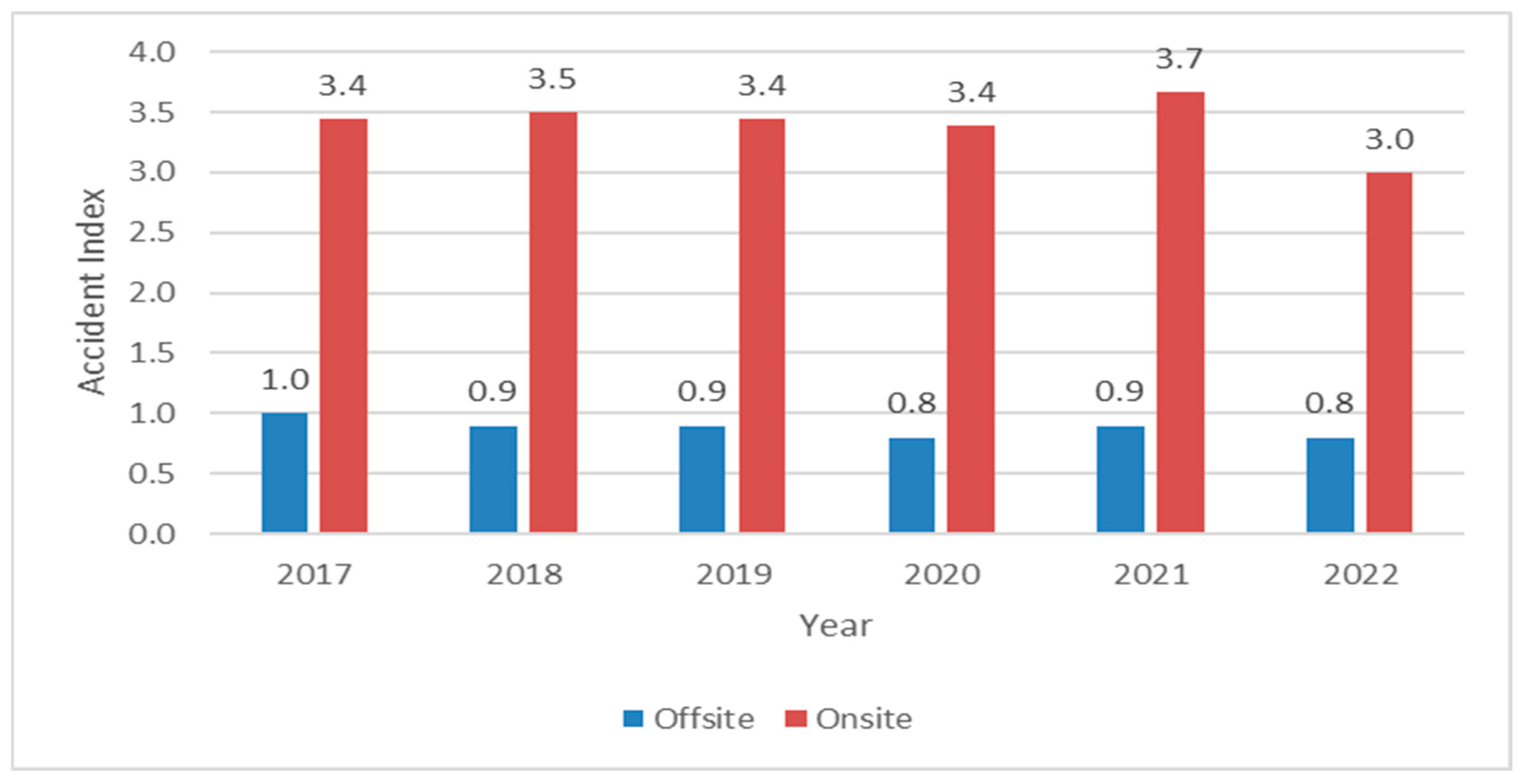

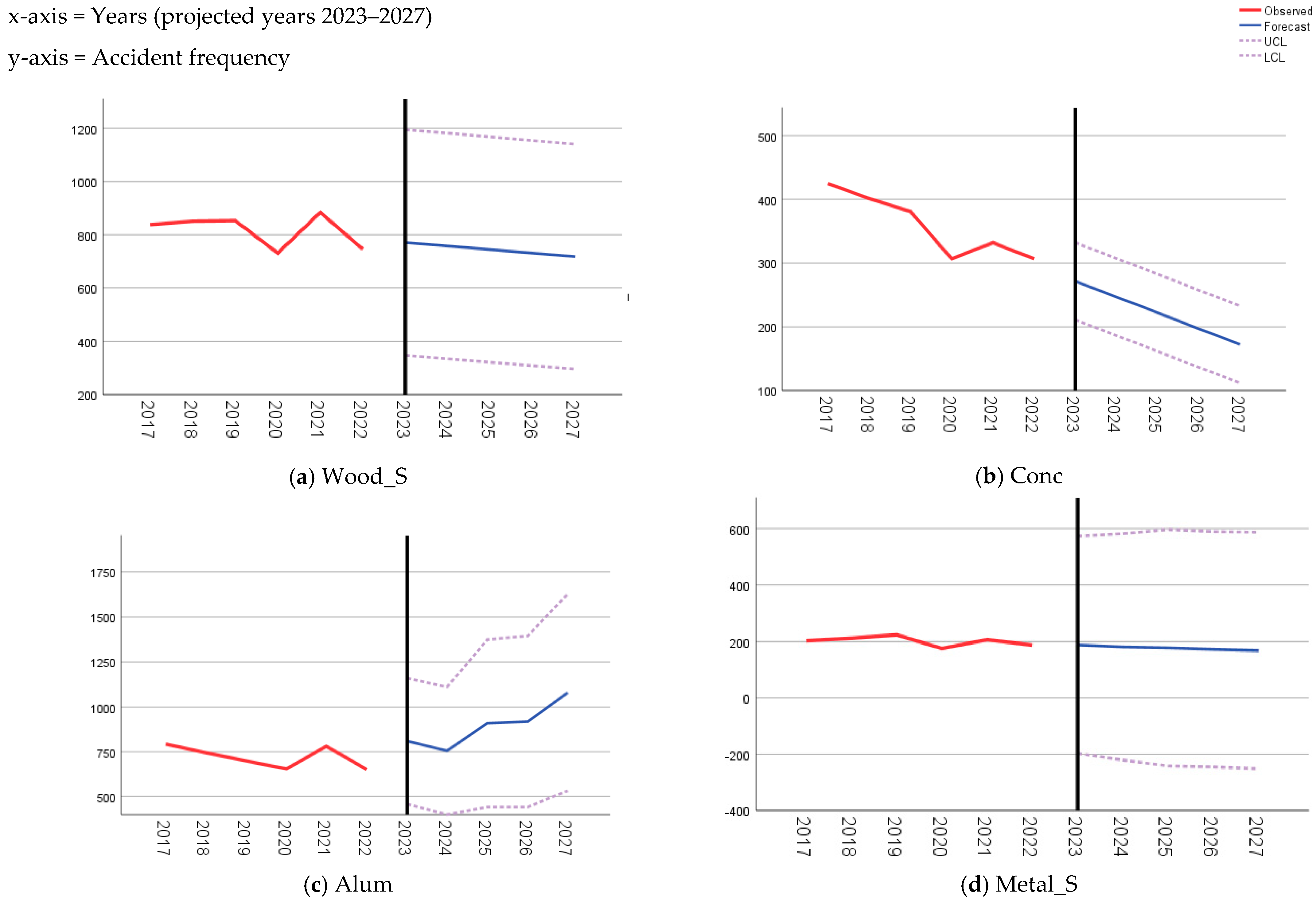
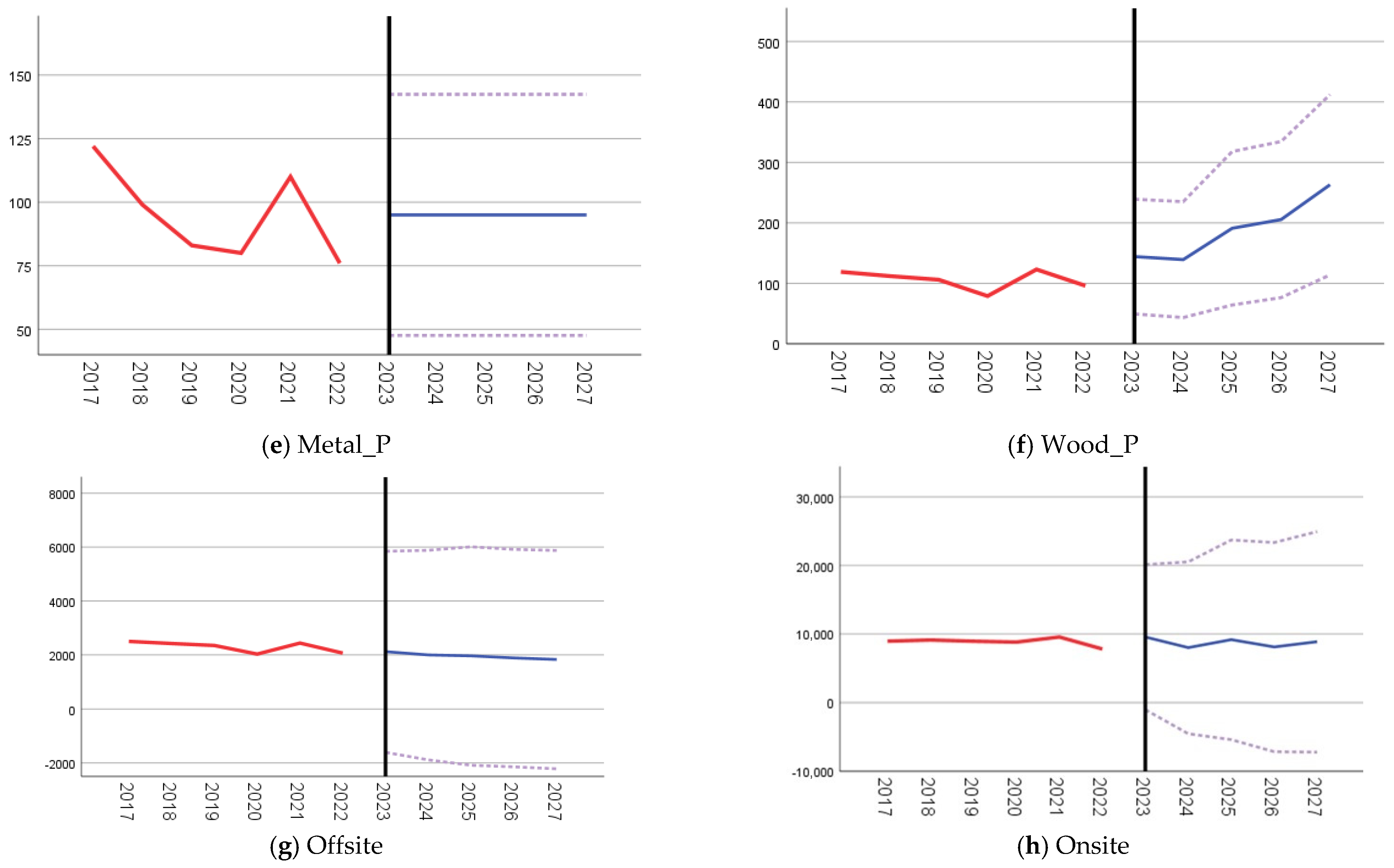

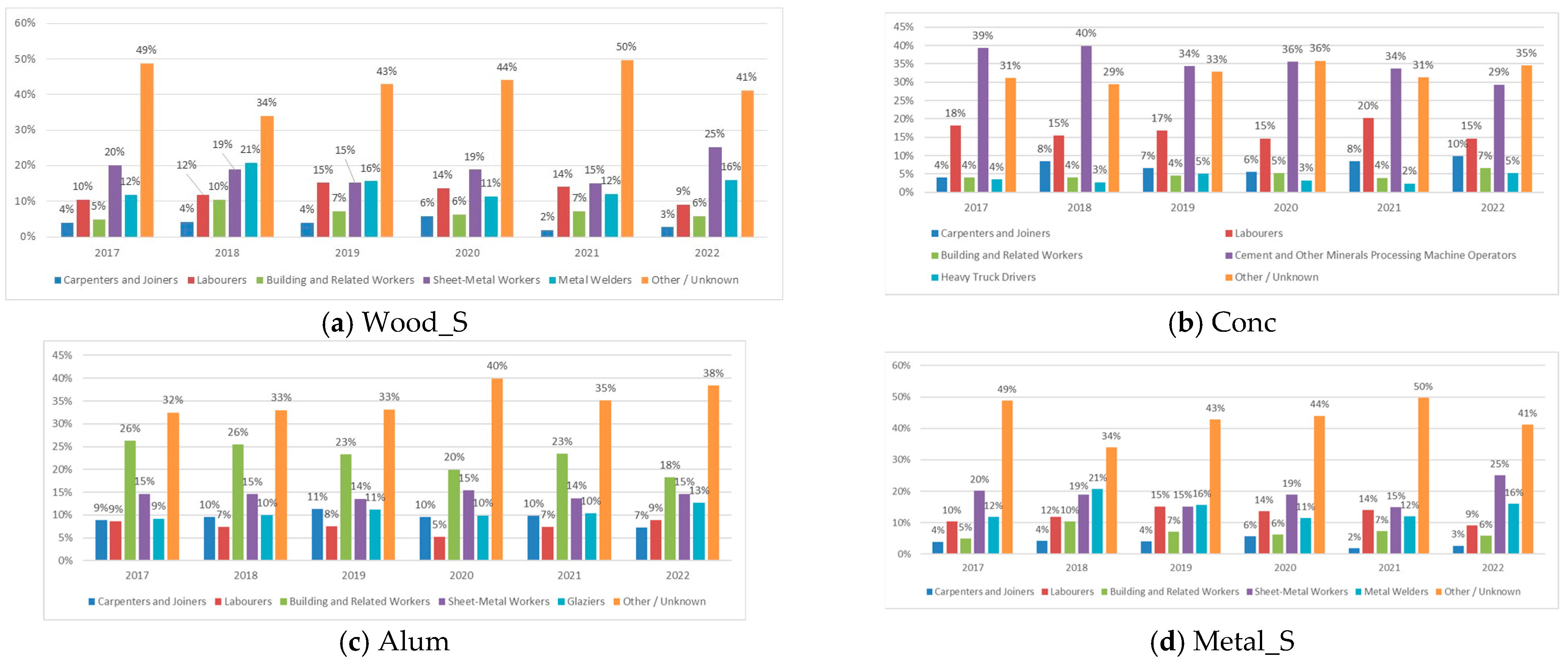

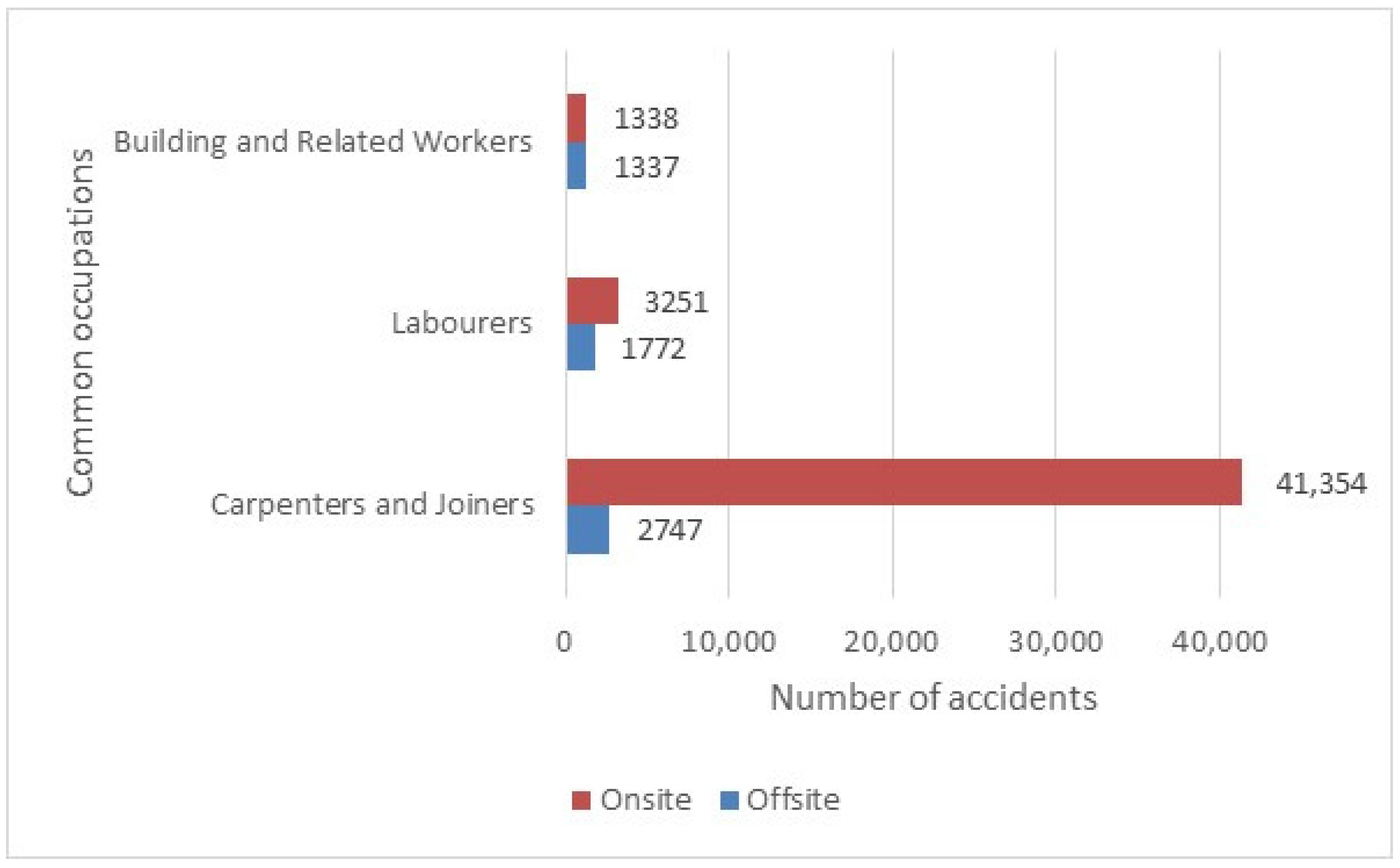
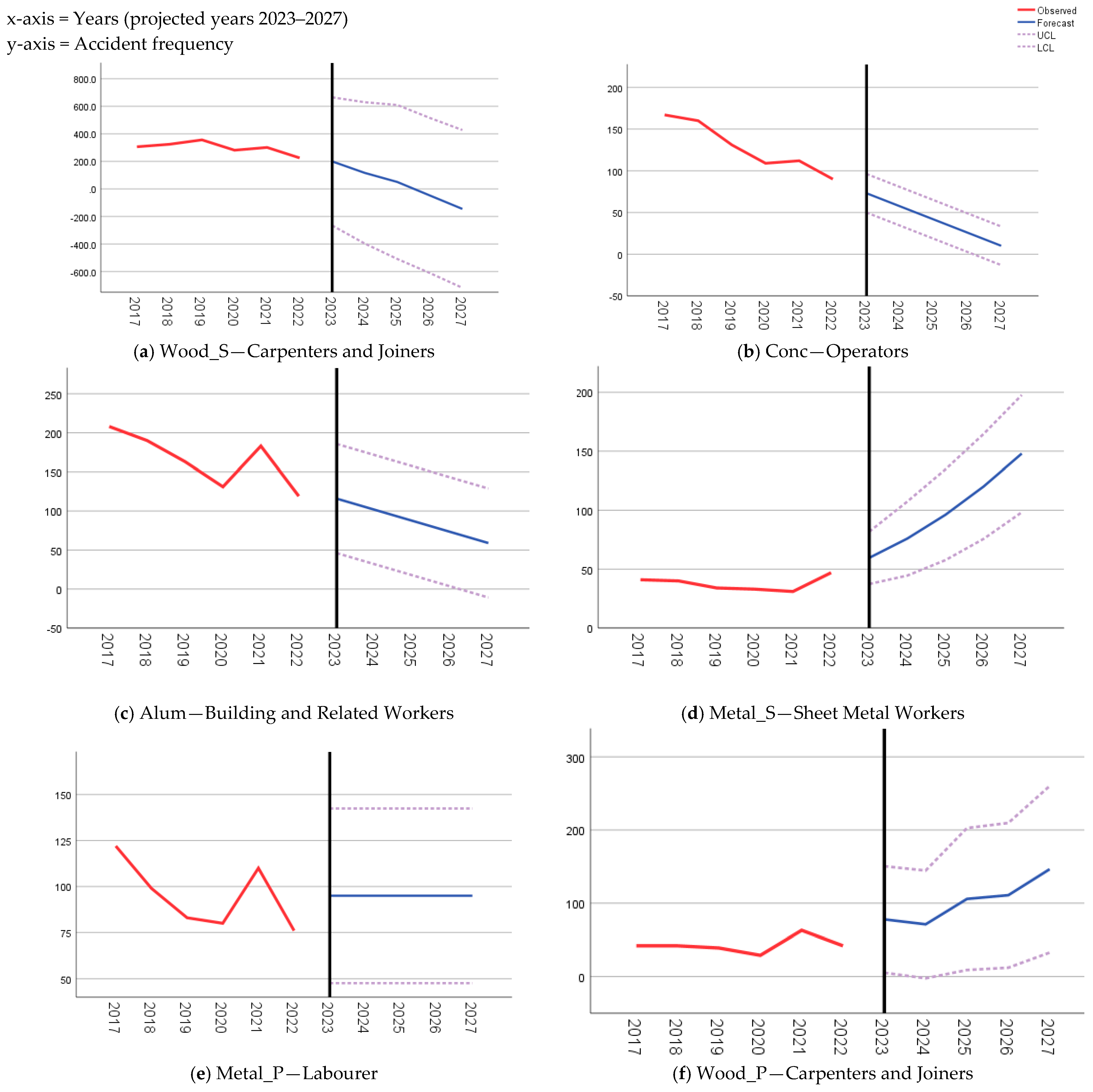
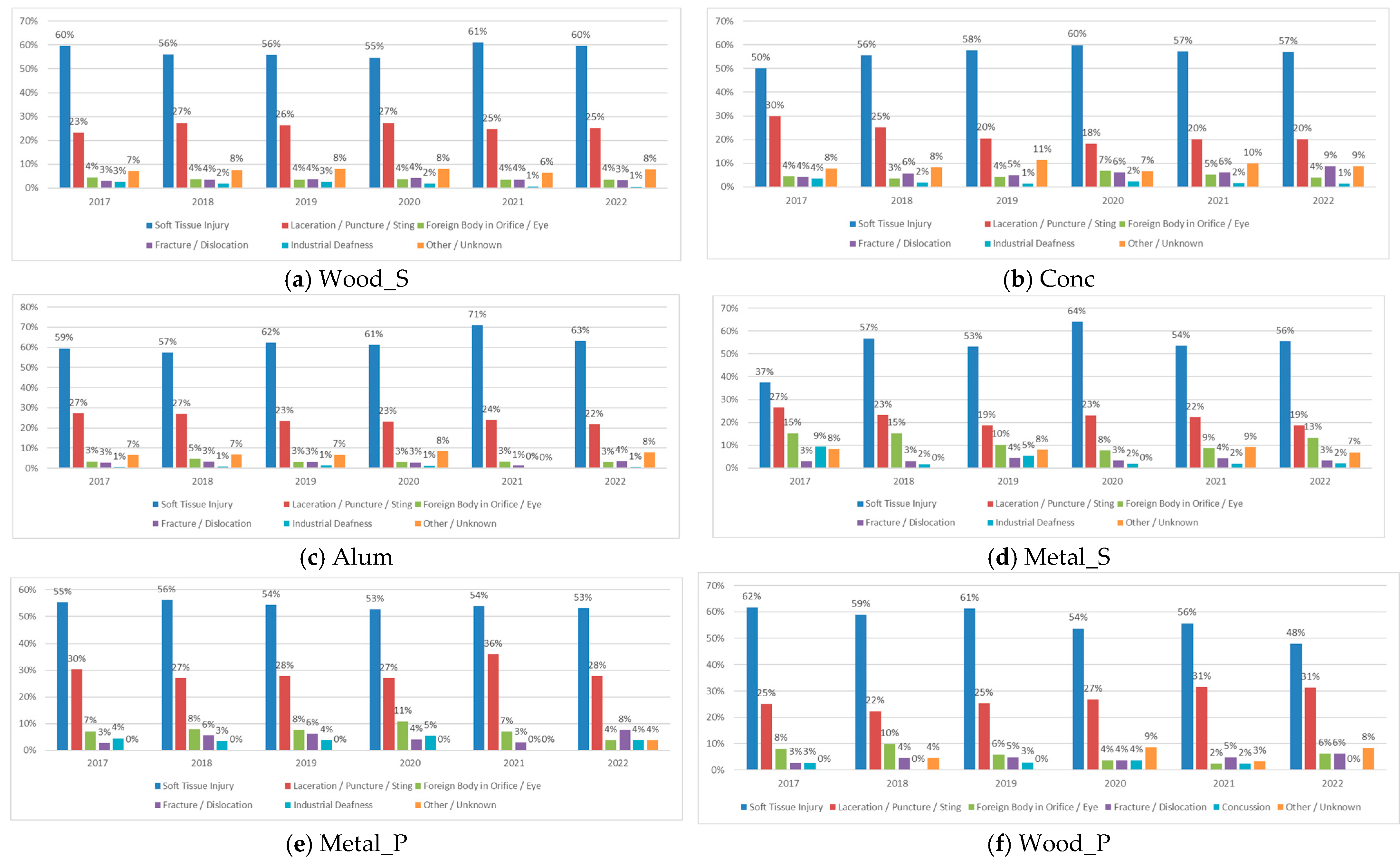
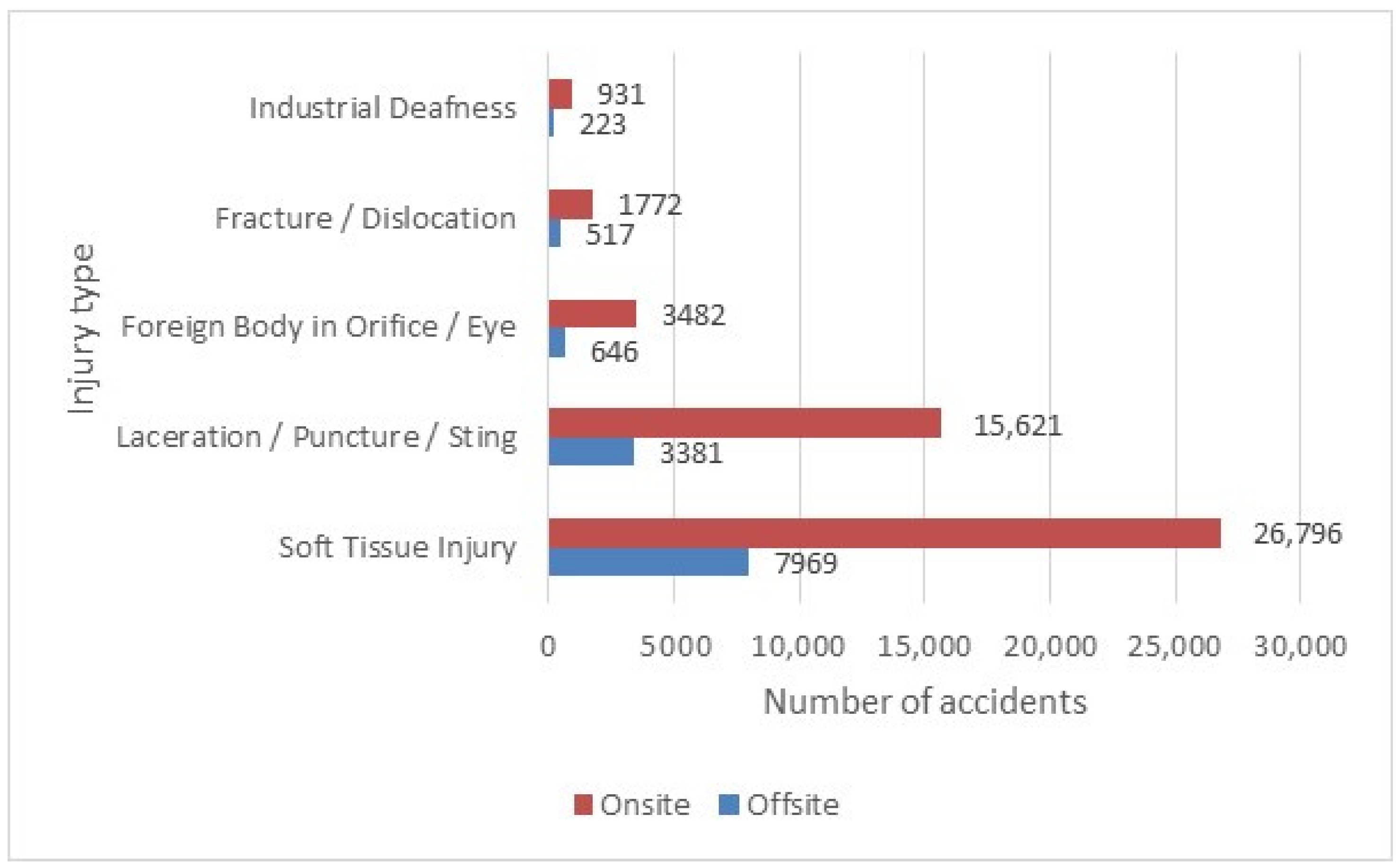
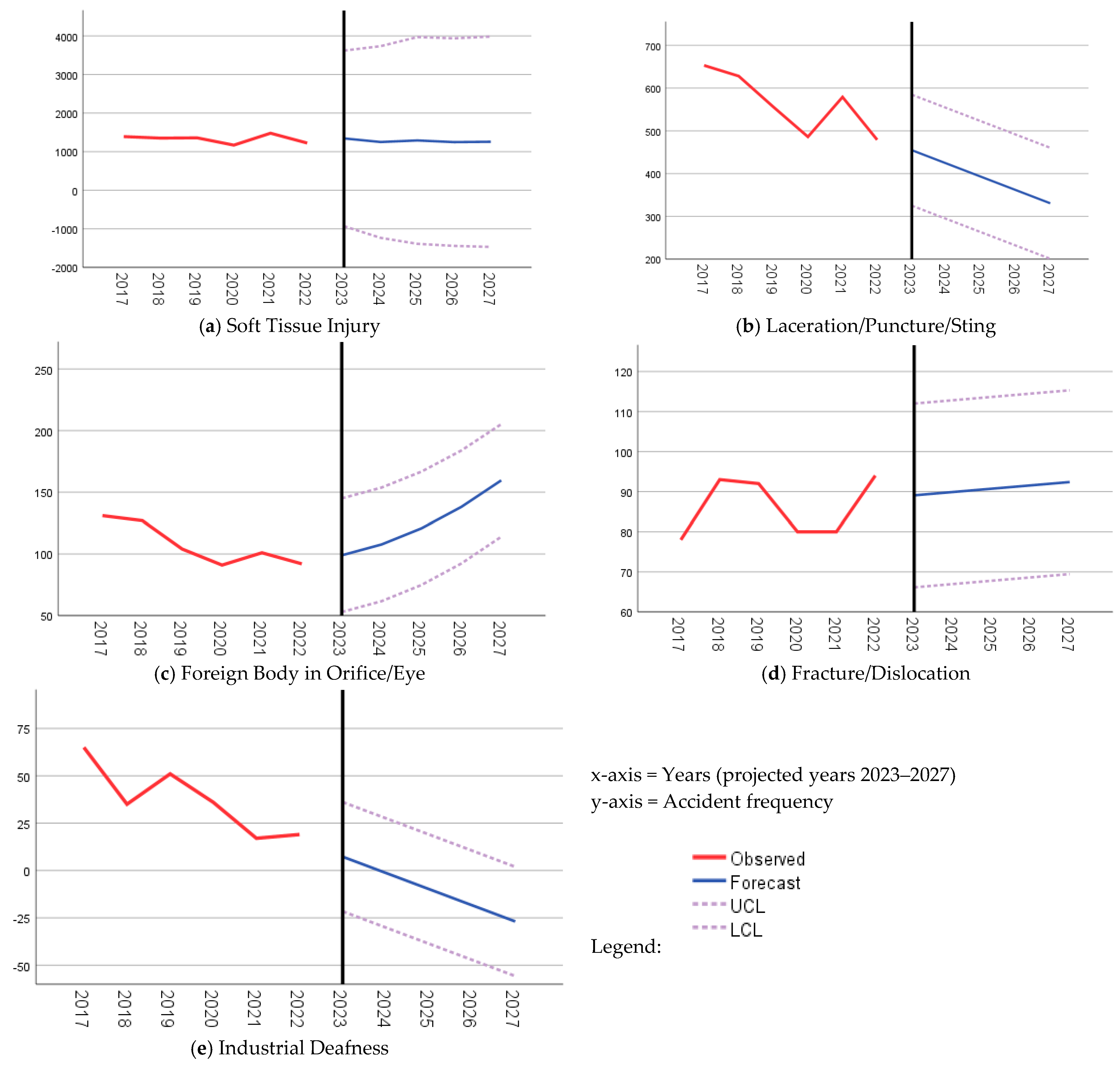


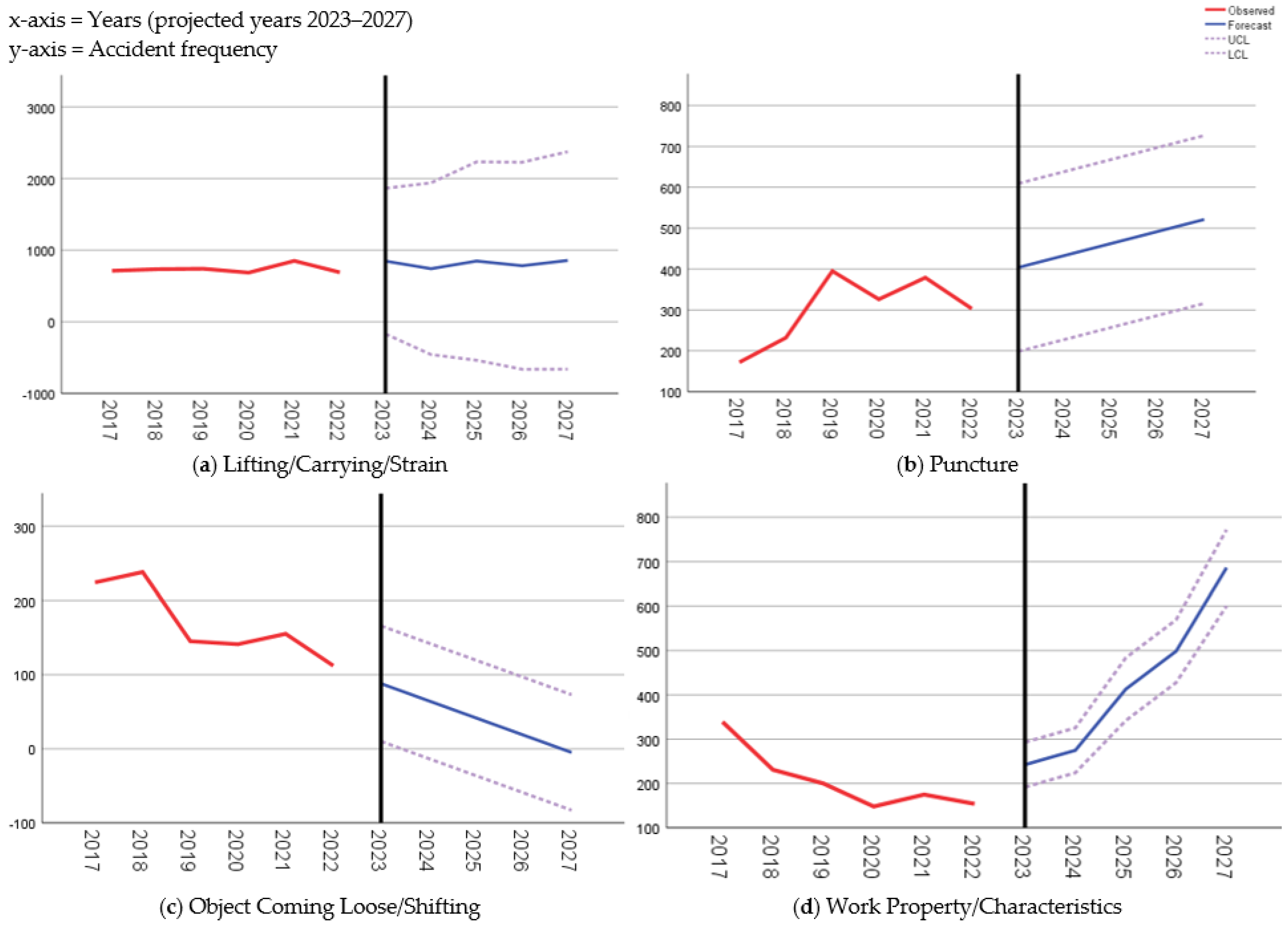
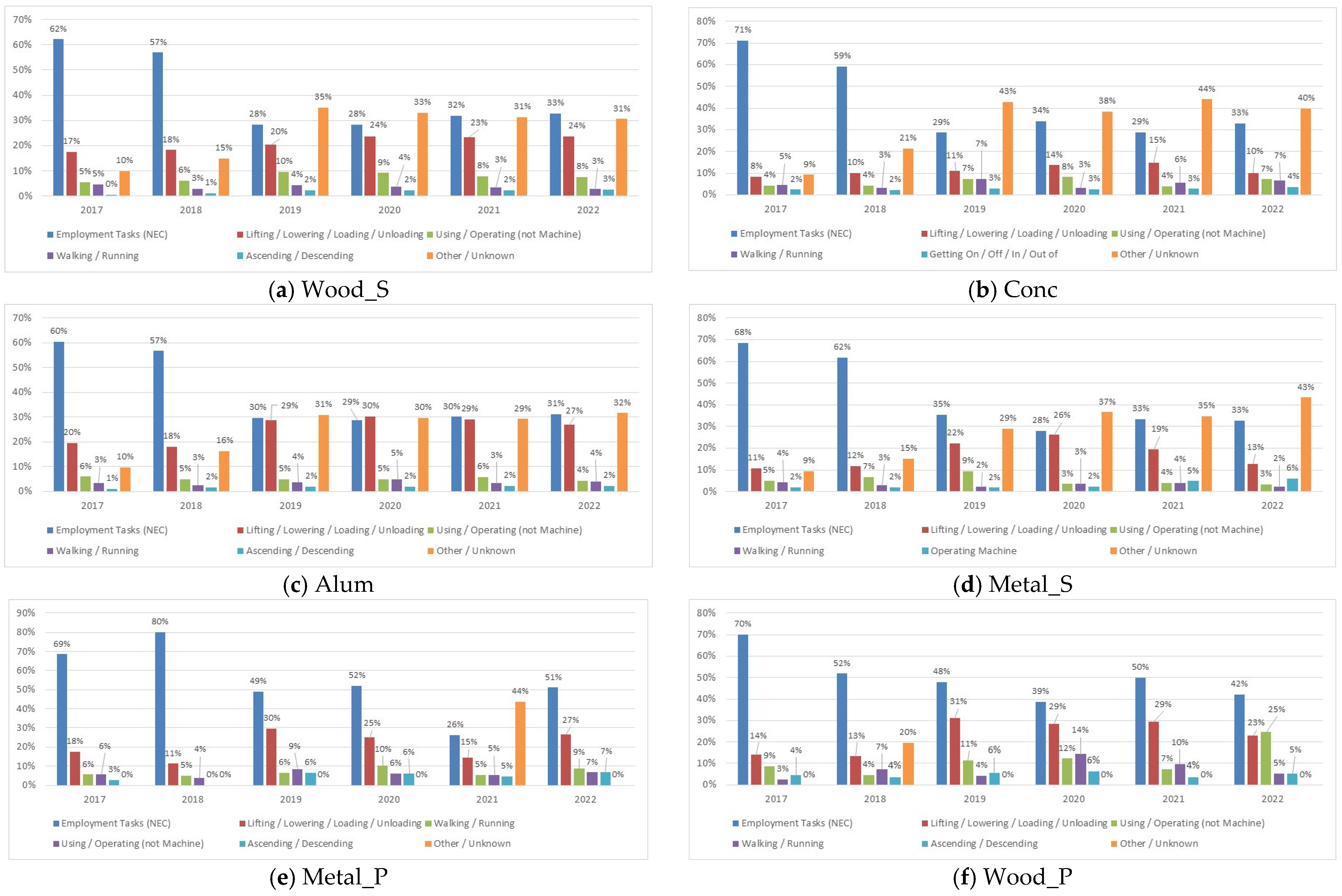
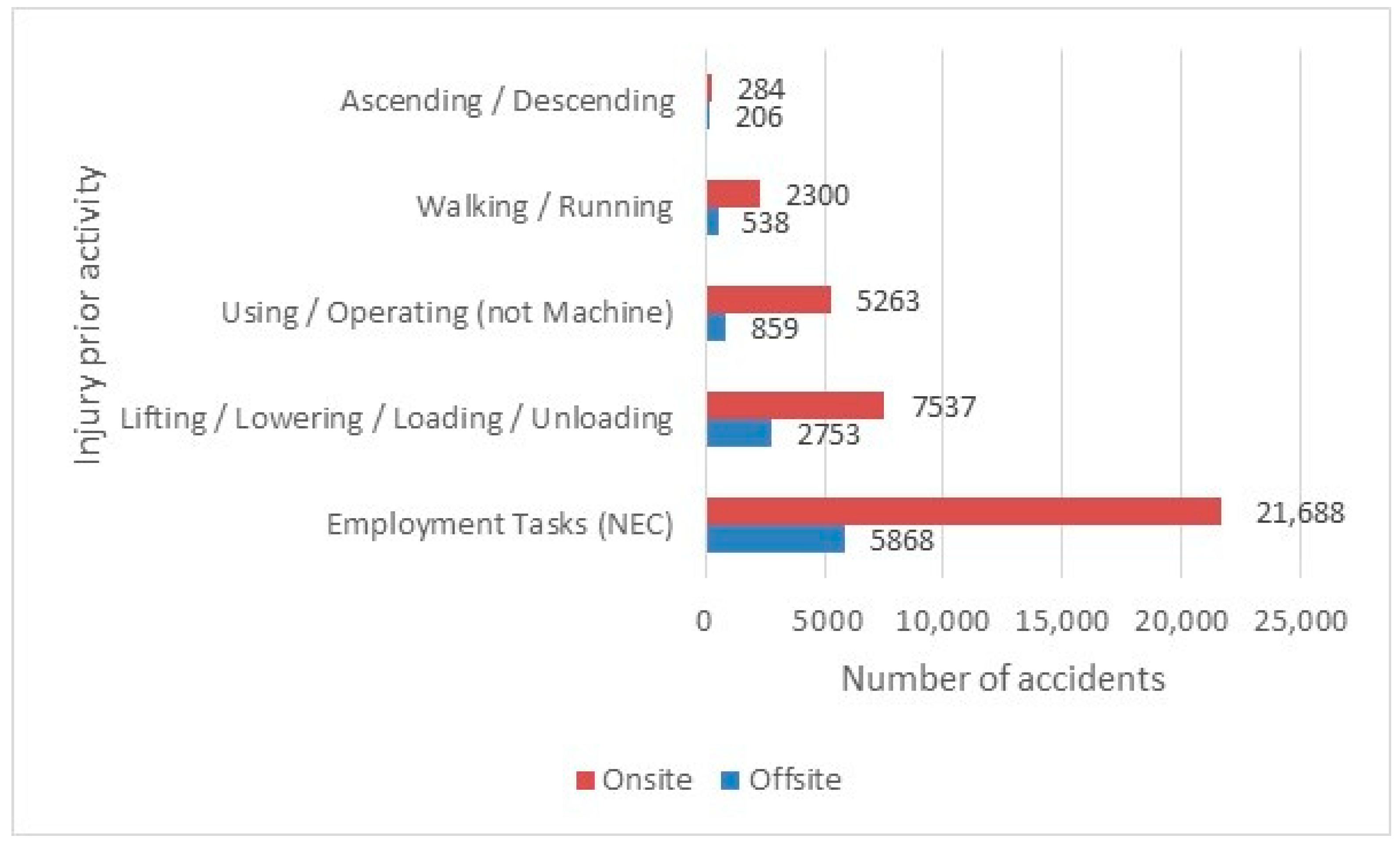


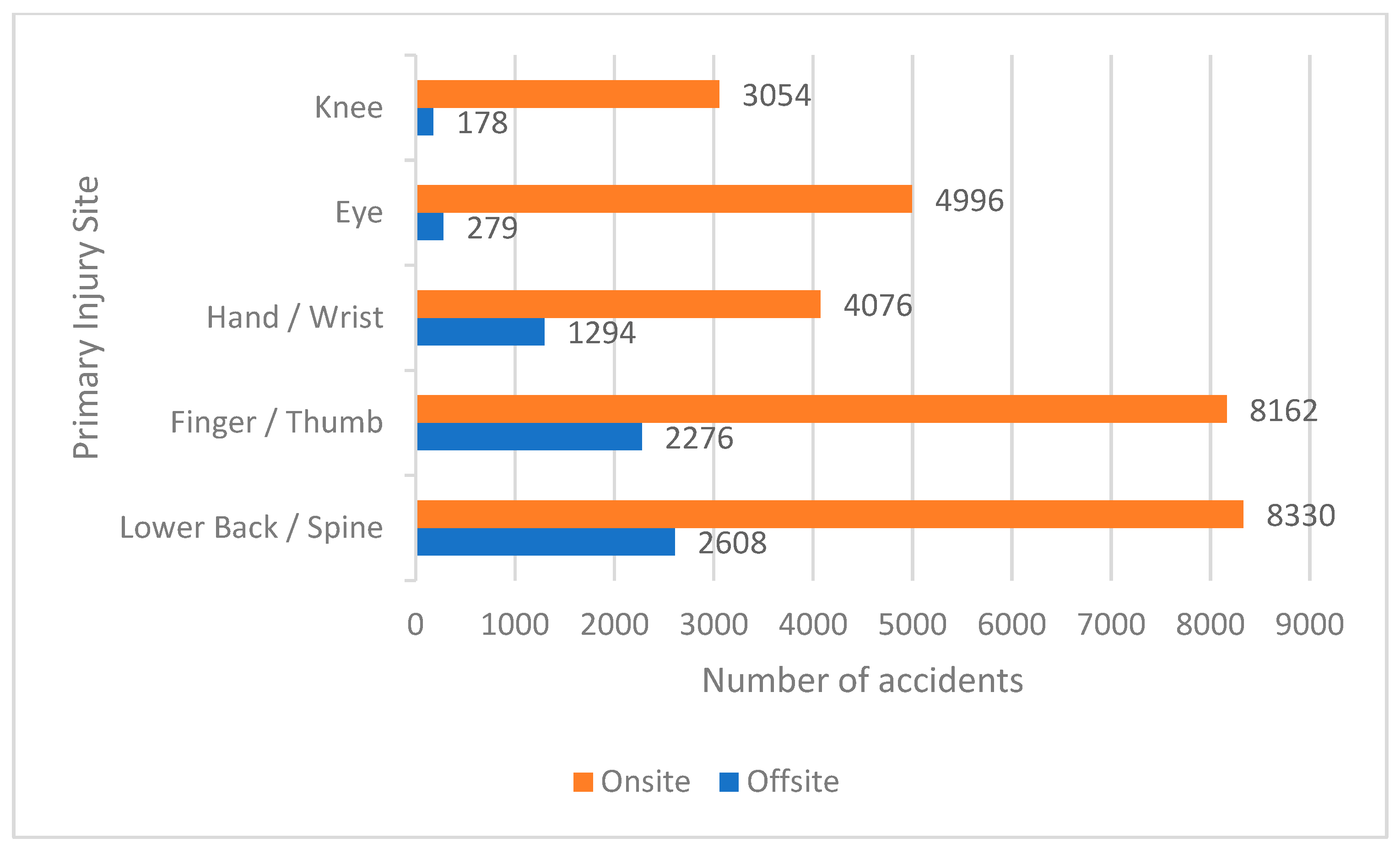
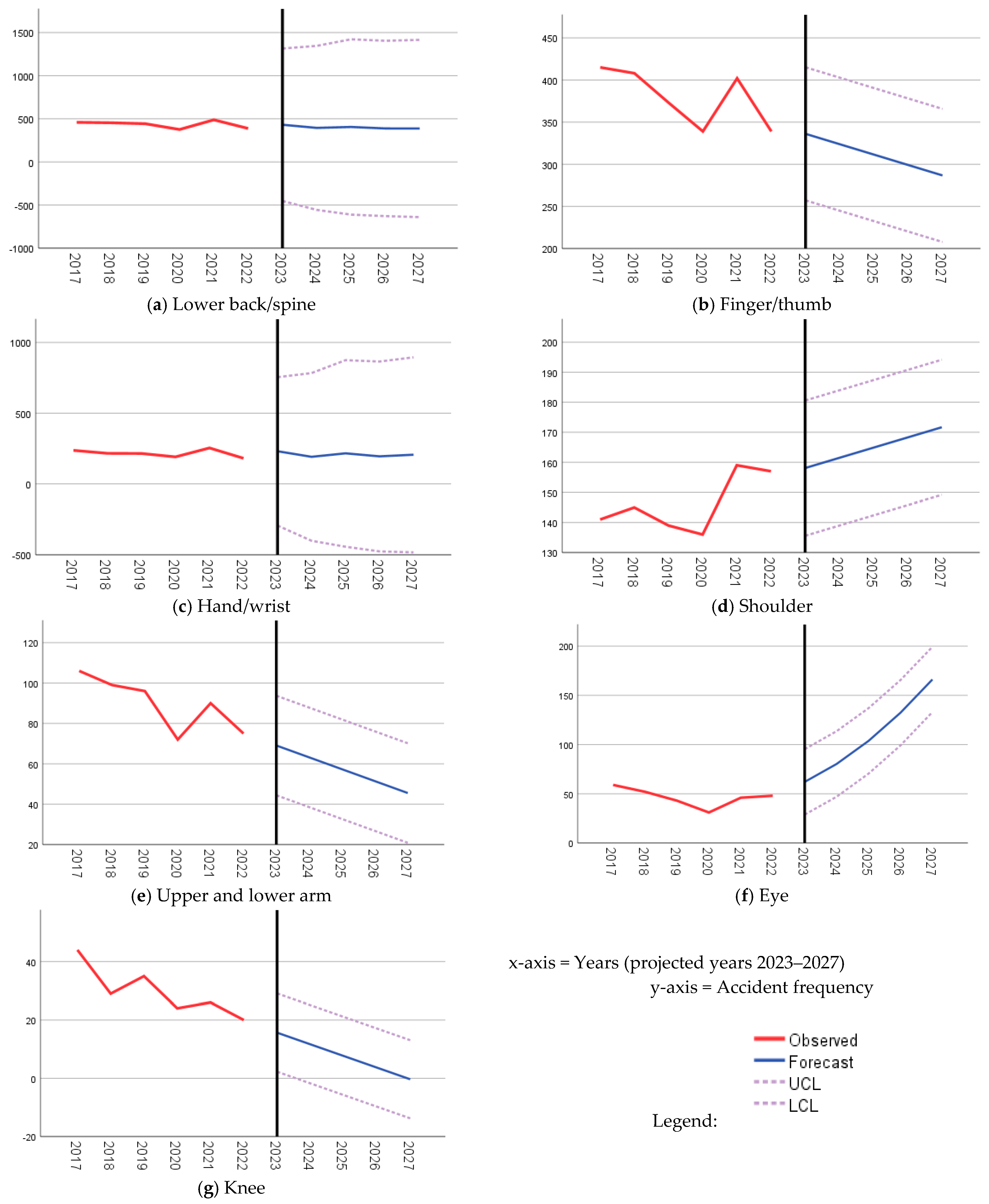
| Abb. | Name | Code | Include | Exclude |
|---|---|---|---|---|
| Wood_S | Wooden structural fittings and components manufacturing | 23230 | Manufacturing, as well as manufacturing and installing; wooden cabinetry, staircases, roof trusses/pre-nail, window frames, doors | Fabrication and installation of joinery on a building site |
| Conc | Concrete product manufacturing | 26350 | Manufacturing fibre cement weatherboards and cladding, concrete roofing components, precast walls/floors/ceilings | - |
| Alum | Architectural aluminium product manufacturing | 27420 | Manufacturing of aluminium roofing, stairs, staircases, doors/doorframes, gates, garage doors, windows/window frames, screens, shopfronts. Also includes manufacturing in conjunction with the installation of the above products. | - |
| Metal_S | Structural metal product manufacturing | 274090 | Manufacturing metal (except aluminium) balconies, balustrades, curtain walls, doors or door frames, fascias, prefabricated fire escapes, partitions, and railings. Also includes manufacturing in conjunction with installation of the above products. | - |
| Metal_P | Prefabricated metal building manufacturing | 29110 | Manufacture of metal sheds, carports, bus shelters, kitset homes | Manufacture of prefabricated buildings in conjunction with onsite erection/assembly of buildings. |
| Wood_P | Prefabricated wooden building manufacturing | 29190 | Manufacturing of wooden prefab houses/kit set dwellings, garages, wooden sheds | Manufacture of prefabricated buildings in conjunction with onsite erection/assembly of buildings. |
| Stats | Wood_S | Conc | Alum | Metal_S | Metal_P | Wood_P | Offsite | Onsite |
|---|---|---|---|---|---|---|---|---|
| ARIMA Model | 1, 1, 1 | 0, 0, 0 | 1, 1, 0 | 1, 1, 1 | 0, 0, 0 | 1, 1, 0 | 1, 1, 1 | 1, 1, 1 |
| MAPE | 4.655 | 4.010 | 5.469 | 6.364 | 16.336 | 12.297 | 4.686 | 3.716 |
| MAE | 36.853 | 13.130 | 39.119 | 12.821 | 15.333 | 11.928 | 101.441 | 325.809 |
| R2 | 0.495 | 0.851 | 0.067 | 0.136 | 0.000 | 0.097 | 0.356 | 0.524 |
| RMSE | 98.686 | 21.812 | 81.482 | 36.681 | 18.439 | 22.431 | 317.331 | 892.148 |
| BIC | 10.471 | 6.762 | 9.766 | 8.492 | 6.128 | 7.187 | 12.807 | 14.875 |
| Stats | Wood_S | Conc | Alum | Metal_S | Metal_P | Wood_P |
|---|---|---|---|---|---|---|
| Carpenters and Joiners | Cement and Other Minerals Processing, and Machine Operators | Building and Related Workers | Sheet Metal Workers | Labourers | Carpenters and Joiners | |
| ARIMA Model | 1, 1, 1 | 0, 0, 0 | 0, 0, 0 | 0, 1, 0 | 0, 0, 0 | 1, 1, 0 |
| MAPE | 4.357 | 4.605 | 10.386 | 13.613 | 13.613 | 20.060 |
| MAE | 13.992 | 5.619 | 16.143 | 5.040 | 5.040 | 8.343 |
| R2 | 0.789 | 0.940 | 0.584 | 0.139 | 0.139 | 0.058 |
| RMSE | 892.148 | 8.332 | 25.142 | 6.986 | 6.986 | 17.004 |
| BIC | 14.875 | 4.837 | 7.046 | 4.532 | 4.532 | 6.633 |
| Stats | Soft Tissue | Laceration/ Puncture/Sting | Foreign Body in Orifice/Eye | Fracture or Dislocation | Industrial Deafness |
|---|---|---|---|---|---|
| ARIMA Model | 1, 1, 1 | 0, 0, 0 | 0, 1, 1 | 0, 0, 0 | 0, 0, 0 |
| MAPE | 5.055 | 5.619 | 6.733 | 7.818 | 23.363 |
| MAE | 64.047 | 30.619 | 7.117 | 6.695 | 7.444 |
| R2 | 0.352 | 0.659 | 0.632 | 0.420 | 0.747 |
| RMSE | 196.333 | 46.728 | 12.480 | 8.259 | 10.338 |
| BIC | 10.573 | 8.286 | 6.014 | 4.820 | 5.279 |
| Stats | Lifting/ Carrying/Strain | Puncture | Object Coming Loose/Shifting | Work Property/ Characteristics |
|---|---|---|---|---|
| ARIMA Model | 1, 1, 1 | 0, 0, 0 | 0, 0, 0 | 1, 1, 0 |
| MAPE | 3.845 | 17.734 | 11.048 | 5.362 |
| MAE | 18.671 | 50.829 | 18.524 | 10.263 |
| R2 | 0.565 | 0.408 | 0.750 | 0.802 |
| RMSE | 87.417 | 73.965 | 28.055 | 21.621 |
| BIC | 10.229 | 9.204 | 7.266 | 7.113 |
| Stats | Employment Task | Lifting/Lowering/Loading/ Unloading | Using/ Operation | Ascending/ Descending |
|---|---|---|---|---|
| ARIMA Model | 0, 1, 1 | 1, 1, 1 | 1, 1, 0 | 1, 1, 1 |
| MAPE | 17.922 | 10.559 | 11.636 | 9.802 |
| MAE | 150.164 | 47.288 | 16.340 | 3.961 |
| R2 | 0.638 | 0.117 | 0.036 | 0.354 |
| RMSE | 268.954 | 132.075 | 28.461 | 12.934 |
| BIC | 12.155 | 11.054 | 7.663 | 6.407 |
| Stats | Lower Back/Spine | Finger/Thumb | Hand/Wrist | Shoulder | Upper and Lower Arm | Eye | Knee |
|---|---|---|---|---|---|---|---|
| ARIMA Model | 1, 1, 1 | 0, 0, 0 | 1, 1, 1 | 0, 0, 0 | 0, 0, 0 | 0, 1, 1 | 0, 0, 0 |
| MAPE | 5.56 | 5.019 | 8.700 | 4.014 | 6.044 | 11.513 | 11.380 |
| MAE | 22.877 | 18.714 | 18.842 | 5.778 | 4.908 | 4.595 | 3.444 |
| R2 | 0.353 | 0.452 | 0.277 | 0.435 | 0.685 | 0.429 | 0.750 |
| RMSE | 75.388 | 28.44 | 48.031 | 8.101 | 8.876 | 8.519 | 4.83 |
| BIC | 9.933 | 7.293 | 9.031 | 4.781 | 4.964 | 5.25 | 3.747 |
Disclaimer/Publisher’s Note: The statements, opinions and data contained in all publications are solely those of the individual author(s) and contributor(s) and not of MDPI and/or the editor(s). MDPI and/or the editor(s) disclaim responsibility for any injury to people or property resulting from any ideas, methods, instructions or products referred to in the content. |
© 2024 by the author. Licensee MDPI, Basel, Switzerland. This article is an open access article distributed under the terms and conditions of the Creative Commons Attribution (CC BY) license (https://creativecommons.org/licenses/by/4.0/).
Share and Cite
Masood, R. Modelling Prefabricated Construction Safety. Appl. Sci. 2024, 14, 1629. https://doi.org/10.3390/app14041629
Masood R. Modelling Prefabricated Construction Safety. Applied Sciences. 2024; 14(4):1629. https://doi.org/10.3390/app14041629
Chicago/Turabian StyleMasood, Rehan. 2024. "Modelling Prefabricated Construction Safety" Applied Sciences 14, no. 4: 1629. https://doi.org/10.3390/app14041629





